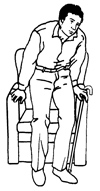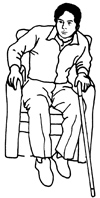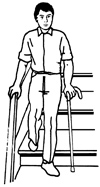Physiotherapy
How to use a cane
This information has been translated into other languages – see the links at the bottom of this page.
A cane is used for balance or when you can take most or all your weight through your weaker or sore leg.

How to fit yourself for a cane
- Put on the shoes you’ll be wearing when you use a cane.
- Stand up straight and relax your shoulders.
- Put the cane in the opposite hand from the weaker leg.
- Put the cane about 10 cm (4 inches) to the side of your stronger leg. Spread your weight evenly between your feet and your cane.
- The hand holding the cane should rest so the elbow is slightly bent. The handgrip should be at wrist level when your arm is hanging by your side.
If you’re using an adjustable cane, unscrew the locking ring (if there is one). Then push in the button, sliding the tubing in or out to reach the best position for you. Make sure the push button has fully snapped into the hole and tighten the locking ring (if there is one) after adjusting.
Note: A wooden cane has to be cut with a saw to the right length. Make sure the rubber tip is securely put back on the end of the wooden cane.
Walking
- Stand with the cane about 10 cm (4 inches) to the side of your stronger leg.
- Shift your weight to your stronger leg and move the cane 10 cm (4 inches) in front of you.
- Move your weaker leg forward so it’s even with the cane.
- Shift your weight to your weaker leg and the cane. Now move the stronger leg forward, ahead of the cane.
- Move your cane forward, and then bring your weaker foot forward until it’s even with your cane.
Repeat these steps. Remember to use good posture—straight back and tummy muscles in.
Move the cane forward —Move your weaker leg forward—Move the stronger leg forward.

Sitting

- To sit down, stand with the backs of your legs just touching the chair.
- Slide your weaker leg forward.
- Move the cane out from your side; lean it on the chair and reach back with both hands to grab onto the armrests or the seat of the chair.
- Lower yourself gently onto the chair.
- Move yourself back in the chair as needed.
Standing

- To get out of the chair, place your cane on the end of the armrest or in your hand.
- Move yourself closer to the edge of the chair.
- Place your foot on the weaker leg slightly forward.
- Push down on the armrests or seat of the chair and lean slightly forward. Then push yourself up with your stronger leg.
- Steady yourself. Move the cane’s tip about 10 cm (4 inches) to the side of your stronger leg.
Walk as instructed above.
Note: If possible, don’t use an unstable or very low chair.
Stairs
If there’s a safe handrail on the stairs, use it. The cane will then go in the other hand.

Going up stairs
- Stand close to the bottom step.
- Hold onto the handrail if there is one.
- Lift your stronger leg up first. Balance your weight between the cane, handrail, and your weaker leg.
- Lift your cane and weaker leg up to the first step. Use the handrail to help lift you up.
Climb 1 step at a time using this pattern.

Going down stairs
- Stand close to the edge of the first step.
- Hold onto handrail if there is one.
- Lower your cane and weaker leg on to the first step.
- Lower your stronger leg on to the same step.
Go down 1 step at a time using this pattern.
Safety tips
- Always wear non-skid, supportive shoes. Don’t wear open-heeled sandals, clogs, or slippers.
- Make sure the cane tip is in good condition with no cracks or tears and wearing evenly.
- Attach an ice pick to the end of your cane if you’re using it in winter. Remember to flip the ice pick down if it’s icy out and flip the ice pick up when you’re indoors.
- Watch for wet or uneven surfaces. Take small steps if you must walk on wet or uneven surfaces.
- Remove loose mats and rugs, electric cords, and cables from the floors in your home. They could cause you to trip or slip.
If you’re using a cane after leg surgery, your doctor or physiotherapist will tell you when you can stop using it.
To see this information online and learn more, visit MyHealth.Alberta.ca/health/pages/conditions.aspx?Hwid=custom.ab_physio_cane_inst.

Other languages
Physiotherapy: How to use a cane
For 24/7 nurse advice and general health information call Health Link at 811.
Current as of: November 14, 2023
Author: Allied Health (Physiotherapy), Alberta Health Services
This material is not a substitute for the advice of a qualified health professional. This material is intended for general information only and is provided on an "as is", "where is" basis. Although reasonable efforts were made to confirm the accuracy of the information, Alberta Health Services does not make any representation or warranty, express, implied or statutory, as to the accuracy, reliability, completeness, applicability or fitness for a particular purpose of such information. Alberta Health Services expressly disclaims all liability for the use of these materials, and for any claims, actions, demands or suits arising from such use.
